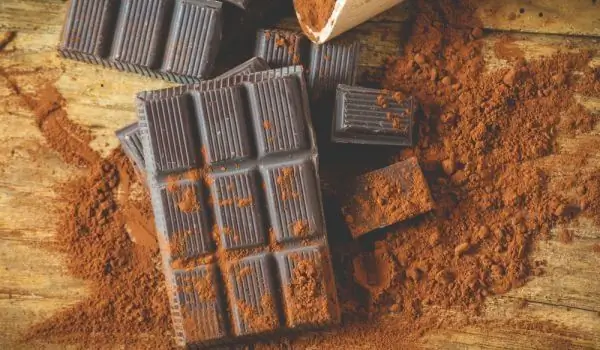2025 Author: Jasmine Walkman | [email protected]. Last modified: 2025-01-23 10:18
Often, due to ignorance, chocolates, be they dark, milk, etc., are placed under a common denominator. The carbohydrates that chocolate is full of are the preferred source of energy from the human body. This is because they are much easier and faster to metabolize than fat. And they are criminally delicious.
In order to distinguish real from low-quality chocolate, as well as the respective subspecies, we must first understand what lies behind the term "real chocolate". To our delight, the law itself explains this. The Ordinance on the requirements for cocoa and chocolate products - Decree № 251 of the Council of Ministers of 2002 states:
Art. 4 (1): The name "Chocolate" is used to denote a product obtained from cocoa products and sugars, containing not less than 35 per cent total dry cocoa mass, of which not less than 18 per cent cocoa butter and not less than 14 per cent dry skimmed cocoa mass. However, in Art. 13 (2) allows producers to add vegetable fats to chocolate products.

(2) The quantity of vegetable fats in the chocolate products may not exceed 5 per cent of the total mass of the final product, which shall be calculated after subtraction of the mass of the added food ingredients under Art. 12, which may not be more than 40 percent of the total mass of the final product.
(3) Upon addition of vegetable fats, other than cocoa butter, reduction of the minimum content of total dry cocoa mass and cocoa butter, established in art. 4.
"Real chocolate", or the so-called "Natural chocolate" must contain the following ingredients: cocoa butter, cocoa mass (ground, baked and with the skin removed - "flake" cocoa beans), sugar, emulsifier - usually used lecithin (E322) and vanilla.

"Real milk chocolate", preferred by children and younger consumers, in addition to the above ingredients may also contain: milk powder (whole and skimmed), cream powder, lactose, dry whey, cow butter, etc.. dairy ingredients. Cocoa butter can also be added.
In "real white chocolate" the main ingredients are cocoa butter, sugar, milk powder and emulsifier.
Anything outside these established norms is poor quality chocolate.
When buying chocolate, pay attention to the ingredients. If it contains vegetable fats, then it is again of a lower class and in fact - by law it is chocolate, but it is not real. Pay attention to the date of manufacture. Look for as freshly produced chocolate as possible, as its aroma and taste change over time, especially with milk chocolate.

Quality chocolate must be packed with aluminum foil and it can now have another package - paper, box and more. The aluminum foil is designed to protect the product from thermal changes during storage, and also preserves the taste of the product - color, aroma, shine, hardness and more.
The storage temperature of chocolate is also very important. Chocolate is very sensitive at temperatures higher than 30 ° C. Therefore, it should not be exposed to direct sunlight. If it melts, it will temper during subsequent spontaneous crystallization and the so-called "oil bloom" will appear - the chocolate turns white, becomes soft and shapeless.
The best quality imported chocolate is from Germany, Belgium and Switzerland. In these three countries, the use of hydrogenated vegetable oils is limited. They have strict legislation stating that once it is chocolate, it is only made with cocoa products without vegetable oils.
The price of chocolate in some cases will show you whether it is real or not. If an average chocolate is sold on the stand at a price of up to BGN 1 or less, it will most likely have nothing to do with the taste of real chocolate. And you will see for yourself after trying it. The price of 1 kg of real chocolate in most European countries varies from 25-45 euros per kilogram, but the quality is worth the price.
Recommended:
To Distinguish Hunger From Appetite

Until one learns that hunger and ordinary appetite are not the same thing, the fight against excess weight will be fierce and long. Whatever diet you follow, you need to know how you feel at the moment - whether your stomach is scraping and giving a signal that you really need food or just the thought of forbidden foods obsesses you and exacerbates outright greed.
How To Distinguish Lamb From Mutton?

Lamb is relatively fatty with a specific smell and is classified by quality. It is commonly used in Middle Eastern cuisine, but is also popular in Europe. To be called lamb, it must be from an animal up to 12 months old, regardless of whether it is male or female.
How To Distinguish Good Carbohydrates From Bad Ones

Many women mistakenly try to exclude carbohydrates from their daily diet. The truth is that every human body needs carbohydrates to get energy, and depriving them will lead to the desire to indulge in eating the first thing you come across. What will help you lose weight is the consumption of the right carbohydrates.
And Do You Distinguish Between Dark And Bitter Chocolate?

The chocolate is considered the most popular and preferred delicacy not only for children but also for adults. We eat it in its pure form, add it to confectionery and almost always use it to decorate dishes and drinks. The most common chocolate is milk chocolate, but sometimes we want something different and charming.
Low Carb And Low Fat Diets - Which Give Better Results?

In our desire to lose weight, we often face the biggest problem - which diet to choose. There are countless types of diets that can be summarized in two groups - low carb and low fat. However, in order to choose which of the two to bet on, we need to understand which is more effective.

